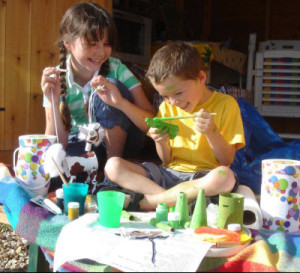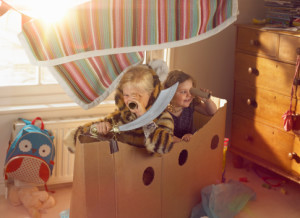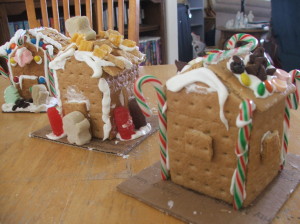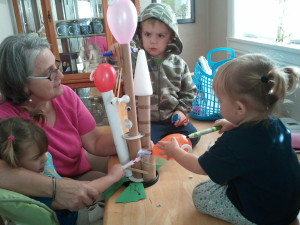
It takes “stuff” for kids to create
Recently someone asked me how I handled it when my children wanted to make something that I knew wasn’t going to be of any use after it was created. How did I feel about them wasting paper, glue and such? That was a really great question and I have been thinking a lot about it. I would change the question to “How do we determine when materials are being well used and when are they being wasted.”
It Takes Lots of “Stuff” for Children to Create
I have seven children, ages 42 through 24. So I have used a lot of paste, glue, rubber bands, construction paper, paper tubes, egg cartons, etc. in my time. We have used thousands of crayons, gone through a few dozen pairs of scissors, innumerable pencils and pens, not to mention compasses, rulers and other drawing devices. We have used rolls of paper, tape, gallons of paint and brushes. In short, we have consumed a great deal of resources.
How do I feel about that? Really, really happy!! Let me share two experiences I have had with children that will demonstrate why I am happy when children use up resources and how I know whether they were well used or just wasted.
The Boat That Was Used For Months!
 When my youngest daughter was about 7 we had purchased something from somewhere that came in a large wooden crate. Of course a large wooden crate is like a magnet for kids. She and her friend were all over that crate. They played in it and on it for a few days.
When my youngest daughter was about 7 we had purchased something from somewhere that came in a large wooden crate. Of course a large wooden crate is like a magnet for kids. She and her friend were all over that crate. They played in it and on it for a few days.
One day Kate came and asked for paint and brushes. When I questioned what she wanted them for she said it was to paint “the boat”. So I gave her some. I never went to see what was happening. I knew they were painting the wooden crate and that now it was a boat and I figured all would be well. They hadn’t asked for my help and I was pretty sure they didn’t want it either.
Next she came in and asked me for a piece of material to make a sail. So I got one for her. She asked if I could help her figure out how to get the sail to stay up. I went out to the boat, gave her some directions and she and her friend went to work. Through out the day they came in and asked me for this thing and that thing and I got whatever they needed or something else that would work.
I didn’t go out to the boat again until they came to say it was done and for me to come and see. Wow! It was such a wonderful thing for a couple of 7 year olds to have created. They played in that boat for a long time. I think they loved it even more because they had made it themselves.
The Four Day, Useless Robot
This summer, Jack, my 6 year old grandson, came in and asked me for a couple of empty paper towel tubes and some glue, “real sticky glue,”

See the random balls and broken necklace. Doesn’t look like a robot, right?
he said. Being the amazing grandma and Spark Station expert that I am, I, of course, had them. I asked Jack what he was making and he said, “A robot”.
Later in the day I had to go upstairs and out to the car for something and as I went out the back door there was Jack busily working away on his robot. It was a square piece of plywood laying flat on the ground. He had used half a jar of glue to glue two round balls on the board and a length of broken necklace. Hmmmm, what in the heck was that. When I went back downstairs I told my husband that he wasn’t making a robot, he was just gluing stuff to piece of board.

The Practically Perfect Robot
The next day as I left for work I was stopped dead in my tracks because right there, at the bottom of the outside steps, was a perfect robot.
Jack had envisioned a robot from a square piece of board and then over the course of half a day he had assembled all the materials he needed and he had created it. I was so amazed. It had looked like a junky piece of board covered with glue and odds and ends the day before, but Jack knew what he was doing. There it was a fabulous and perfect robot.
That robot lay there at the bottom of the outside steps for about four days until it rained. Then
the pieces were gathered up and it went to the junk yard in the sky. Jack’s robot couldn’t be played with or hung on the wall or anything worth while like the boat.
So the question I ask you is, “Was it a waste of materials for Jack to build the robot and should we let kids waste materials to create something that doesn’t have any good use?
My answer would be a resounding YES!!!
In both stories the child had to conceive an idea. Then they had to determine what materials they needed to bring that idea to life. Then they had to take the initiative to gather the materials and organize them in such a way that their vision came to life.
In both cases, since I was somewhat involved and know, they had to do some considerable problem solving to make things work out. They  worked independently for the most part, trusting themselves that they could figure it out and get the job done. At the same time they had to determine when they needed to ask for help, and exactly what help they needed. In Jack’s case, he had to figure out how to get the job done with two smaller siblings getting in the way. Yelling or hitting wasn’t an option. He had to use some diplomacy.
worked independently for the most part, trusting themselves that they could figure it out and get the job done. At the same time they had to determine when they needed to ask for help, and exactly what help they needed. In Jack’s case, he had to figure out how to get the job done with two smaller siblings getting in the way. Yelling or hitting wasn’t an option. He had to use some diplomacy.
In both cases the child was able to look at their finished product and beam from ear to ear because they both knew they had created something and done a spectacular job. They both felt proud for a number of days about their success. Their belief in themselves was strengthened and their ability to “do” increased.
When I look at the results that came from the use of the materials in both cases I have to think that those materials were used practically perfectly. They accomplished what paint, glue, junk, brushes, rubber bands, castoffs, scissors, pencil, pens and all the rest were designed for…to help people do the work of creating and problem solving, and then feel more capable and able than when they started, and feel the pride of having accomplished something that mattered to them.
How do we really know when resources are being well used? The first point is to recognize that adults and children are different in a significant way.
Adults are End-Product Driven but Children are Process Driven
 I have always asserted that children are not adults and consequently they do not think like adults. Adults are end product driven but children are process driven. We as adults care so much about how a thing turns out and if it’s useful. Children care about how it feels to create something. However it turns out they are proud and satisfied unless some adult points out all the flaws.
I have always asserted that children are not adults and consequently they do not think like adults. Adults are end product driven but children are process driven. We as adults care so much about how a thing turns out and if it’s useful. Children care about how it feels to create something. However it turns out they are proud and satisfied unless some adult points out all the flaws.
I have helped a few thousand children in grade schools and home schools make gingerbread houses. I know how creative they are. I also saw many teachers and parents correct their efforts. “Tin foil balls do not belong on chimneys.” “Windows go on the side and not on the roof.” “You have to cover ALL the cracks or it won’t look nice.”
I have seen a child look at their creation with such wonder and joy only to have a parent or teacher point out what they didn’t do correctly. I have seen their pride and joy turn to shame that they didn’t do it “right.”
Remember, you care about the end product. You are going to be viewing your children’s activities through those lenses—unless of course you will consciously take those glasses off in order to see what your children see.
Children care about the process, and how it feels to create. In their minds they see a genius that’s just created a masterpiece. If we can see that too, then our children’s abilities and capabilities will grow and grow until their end products become more recognizably genius.
I Say LET THEM CREATE!
So I say let them create. Don’t manage their efforts. Don’t worry so much about waste. Think instead of what they gain by the act of creation:
• Increased vision
• Initiative
• The ability to bring the vision to life
• The ability to gather together what is needed
• The ability to problem solve
• The ability to work independently
• Learn when to ask for help and what help they need
• Learn to work well with others
• Develop leadership skills and attitudes
• Develop to manage crisis more effectively
• Learn to use diplomacy
If you’ll decide to see your children’s projects differently—how does it feel to your child, and what is the process of creating really teaching them—then you can better evaluate the “right” use of materials.
Besides, couldn’t we use a few more adults around who weren’t afraid to turn their dreams into a reality, because they spent their childhood doing it?
Possibly Related Posts:
- 5 Creative Writing Exercises for Kids of All Ages
- Self Care for Better Parenting – Part 2
- Self Care for Better Parenting – Part 1
- Got Kids 24/7 – 2 Tips to make life easier
- The Screen Free Experiment



{ 3 comments… read them below or add one }
I love this. 🙂 This is something that didn’t come naturally to me. It’s something I am still learning. I have said it a few times today “It’s not about avoiding messes,you make them and clean them up.”
Thank you as always! I needs this right now!!!
Great article Mary Ann!